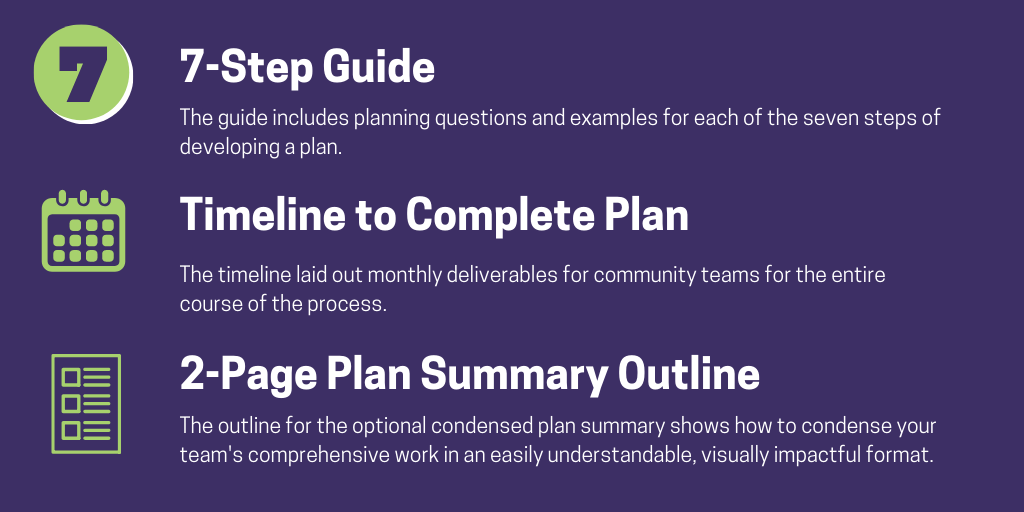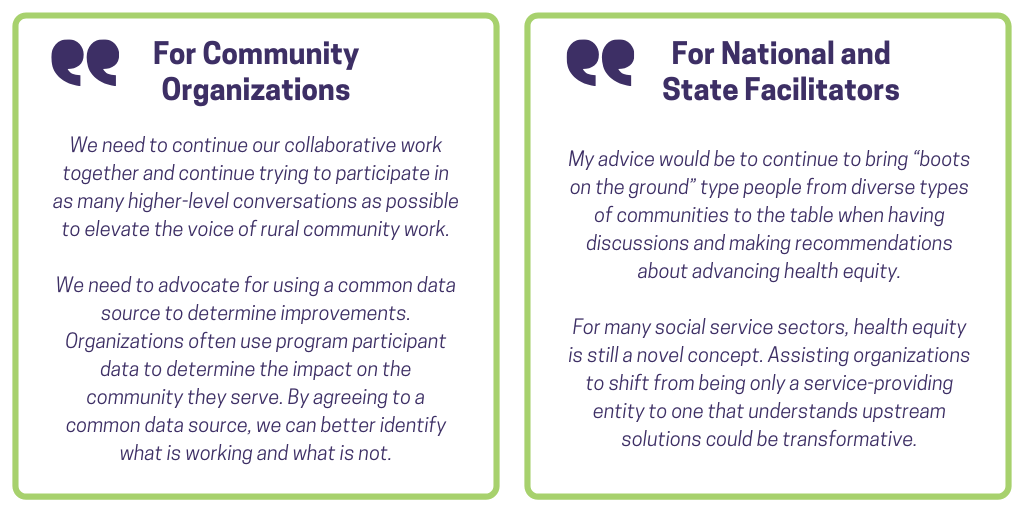Developing Community-Driven Health Equity Action Plans: Lessons Learned During the NAM Pilot Project
This page describes the NAM’s process of facilitating the development of Community-Driven Health Equity Action Plans by five diverse communities across the country. For an overview of the project, visit the Community-Driven Health Equity Action Plan homepage.
Background of the Model
The 2017 National Academies of Sciences, Engineering, and Medicine (National Academies) report Communities in Action: Pathways to Health Equity outlines three key domains for advancing health equity at the community level: 1) building shared vision and values, 2) community capacity, and 3) multi-sector collaboration. The report emphasizes the power that lies in communities and highlights that communities exist in a mix of national-, state-, and local-level policies, forces, and programs.
Based on learnings from communities advancing health equity and scientific evidence from Communities in Action and other National Academies reports, the Culture of Health Program created a model for developing Community-Driven Health Equity Action Plans. The model serves to elevate the community voice and expertise, respond to the diversity of communities, and focus on multi-sectoral and multilevel collaborations and approaches.
Five community teams committed to advancing health equity agreed to pilot the model to develop Community-Driven Health Equity Action Plans. The National Academy of Medicine (NAM) served as the neutral convener and offered support throughout the process.
 Over the course of 18 months, the community teams worked to identify pathways to support equitable good health for residents by employing the model. As the final output, the community teams developed strategy plans that identify a team’s goals, community context, tactics, stakeholders, timeline, and more.
Over the course of 18 months, the community teams worked to identify pathways to support equitable good health for residents by employing the model. As the final output, the community teams developed strategy plans that identify a team’s goals, community context, tactics, stakeholders, timeline, and more.
The model for developing Community-Driven Health Equity Action Plans is designed to be adaptable across a wide variety of contexts. Not all communities or organizations who wish to use the model will require or have access to a convener or facilitator. However, the NAM offers the following lessons learned based on feedback from the pilot community teams as a resource for any project leader employing the model.
Materials Provided to Facilitate Use of the Model

Services Provided to Facilitate Use of the Model
The NAM coordinated in-person meetings, monthly calls, and resource sharing to facilitate the model and the development of the teams’ plans.
Meetings
The NAM hosted three in-person meetings over 18 months, which coincided with the Culture of Health Program’s public workshops. In addition to participating in the public workshops, teams joined a second-day closed session meeting that built in dedicated time for the teams to work on their plans and brought the teams together with leaders in the field. The teams guided the development of each meeting’s focus by sharing input on what they needed to advance a specific part of their health equity work.
- August 2018: Communities shared their experiences addressing health inequities locally. During the closed session meeting, teams learned about using data and metrics to advance goals around civic engagement, socioeconomic mixing, environmental sustainability, and value creation.
- March 2019: Communities learned about the opportunities for partnerships with anchor institutions (including universities, hospitals, health systems, businesses, municipalities and faith-based entities) to advance health equity in surrounding communities by leveraging their financial, intellectual, and human capital. During the closed session meeting, teams explored how to create and support dynamic collaborations and how to use data to engage multi-sectoral partners.
- October 2019: Communities gained knowledge on how to effectively communicate their efforts to address health inequities and the social determinants of health. During the closed session meeting, teams worked with a communications firm to develop a communications strategy and core messages for their plans.
A special thanks to the following speakers who participated during the closed session meetings:
Calls
The NAM facilitated monthly calls for all community teams to receive guidance from and share knowledge with each other and staff. The monthly calls facilitated open communication about successes, barriers, upcoming milestones, and more.
Resources
The community teams collaborated with a number of experts, including members of the Culture of Health Program advisory committee, whose expertise encompasses representation from health systems, the education sector, economics, technology, environmental science, urban planning, finance, community organizing, and local and federal policy.
The NAM also served as a point of contact to provide community teams with recommendations from National Academies’ reports, resources and materials from the Robert Wood Johnson Foundation, and other relevant learnings and guidance as needed.
Collaboration and Communications
The teams expressed particular appreciation for the model’s collaboration opportunities and its focus on communications, as is evident in the following quotes from pilot project community leaders.

Calls to Action
Achieving health equity is an ongoing journey. The NAM hopes the model for developing Community-Driven Health Equity Action Plans serves as a useful resource for community organizations as well as national and state facilitators interested in advancing health equity in their specific contexts.
The teams who developed Community-Driven Health Equity Action Plans offer the following calls to action after their participation in the pilot project.

Related Products

